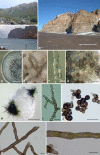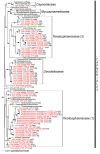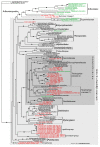Phylogeny of rock-inhabiting fungi related to Dothideomycetes
- PMID: 20169026
- PMCID: PMC2816969
- DOI: 10.3114/sim.2009.64.06
Phylogeny of rock-inhabiting fungi related to Dothideomycetes
Abstract
The class Dothideomycetes (along with Eurotiomycetes) includes numerous rock-inhabiting fungi (RIF), a group of ascomycetes that tolerates surprisingly well harsh conditions prevailing on rock surfaces. Despite their convergent morphology and physiology, RIF are phylogenetically highly diverse in Dothideomycetes. However, the positions of main groups of RIF in this class remain unclear due to the lack of a strong phylogenetic framework. Moreover, connections between rock-dwelling habit and other lifestyles found in Dothideomycetes such as plant pathogens, saprobes and lichen-forming fungi are still unexplored. Based on multigene phylogenetic analyses, we report that RIF belong to Capnodiales (particularly to the family Teratosphaeriaceae s.l.), Dothideales, Pleosporales, and Myriangiales, as well as some uncharacterised groups with affinities to Dothideomycetes. Moreover, one lineage consisting exclusively of RIF proved to be closely related to Arthoniomycetes, the sister class of Dothideomycetes. The broad phylogenetic amplitude of RIF in Dothideomycetes suggests that total species richness in this class remains underestimated. Composition of some RIF-rich lineages suggests that rock surfaces are reservoirs for plant-associated fungi or saprobes, although other data also agree with rocks as a primary substrate for ancient fungal lineages. According to the current sampling, long distance dispersal seems to be common for RIF. Dothideomycetes lineages comprising lichens also include RIF, suggesting a possible link between rock-dwelling habit and lichenisation.
Keywords: Arthoniomycetes; Capnodiales; Dothideomycetes; evolution; extremotolerance; multigene phylogeny; rock-inhabiting fungi.
Figures




Similar articles
-
Rock-inhabiting fungi originated during periods of dry climate in the late Devonian and middle Triassic.Fungal Biol. 2011 Oct;115(10):987-96. doi: 10.1016/j.funbio.2011.04.002. Epub 2011 May 7. Fungal Biol. 2011. PMID: 21944211
-
A rock-inhabiting ancestor for mutualistic and pathogen-rich fungal lineages.Stud Mycol. 2008;61:111-9. doi: 10.3114/sim.2008.61.11. Stud Mycol. 2008. PMID: 19287533 Free PMC article.
-
Extremotolerant fungi from alpine rock lichens and their phylogenetic relationships.Fungal Divers. 2016;76:119-142. doi: 10.1007/s13225-015-0343-8. Epub 2015 Aug 22. Fungal Divers. 2016. PMID: 26877720 Free PMC article.
-
Fungal Diversity in Lichens: From Extremotolerance to Interactions with Algae.Life (Basel). 2018 May 22;8(2):15. doi: 10.3390/life8020015. Life (Basel). 2018. PMID: 29789469 Free PMC article. Review.
-
Rock-inhabiting fungi: terminology, diversity, evolution and adaptation mechanisms.Mycology. 2021 Dec 27;13(1):1-31. doi: 10.1080/21501203.2021.2002452. eCollection 2022. Mycology. 2021. PMID: 35186410 Free PMC article. Review.
Cited by
-
Functions of fungal melanin beyond virulence.Fungal Biol Rev. 2017 Mar;31(2):99-112. doi: 10.1016/j.fbr.2016.12.003. Epub 2017 Jan 18. Fungal Biol Rev. 2017. PMID: 31649746 Free PMC article.
-
Endolichenic Fungal Community Analysis by Pure Culture Isolation and Metabarcoding: A Case Study of Parmotrema tinctorum.Mycobiology. 2022 Feb 24;50(1):55-65. doi: 10.1080/12298093.2022.2040112. eCollection 2022. Mycobiology. 2022. PMID: 35291596 Free PMC article.
-
Interaction between Fungal Communities, Soil Properties, and the Survival of Invading E. coli O157:H7 in Soils.Int J Environ Res Public Health. 2020 May 18;17(10):3516. doi: 10.3390/ijerph17103516. Int J Environ Res Public Health. 2020. PMID: 32443436 Free PMC article.
-
A single septin from a polyextremotolerant yeast recapitulates many canonical functions of septin hetero-oligomers.Mol Biol Cell. 2024 Oct 1;35(10):ar132. doi: 10.1091/mbc.E24-05-0227. Epub 2024 Aug 28. Mol Biol Cell. 2024. PMID: 39196657 Free PMC article.
-
Community Analyses Uncover High Diversity of Lichenicolous Fungi in Alpine Habitats.Microb Ecol. 2015 Aug;70(2):348-60. doi: 10.1007/s00248-015-0579-6. Epub 2015 Mar 21. Microb Ecol. 2015. PMID: 25792281
References
-
- Arnold AE, Miadlikowska J, Higgins KL, Sarvate SD, Gugger P, Way A, Hofstetter V, Kauff F, Lutzoni F (2009). A phylogenetic estimation of trophic transition networks for ascomycetous fungi: are lichens cradles of symbiotrophic fungal diversification? Systematic Biology 58: 283–297. - PubMed
-
- Bills GF, Collado J, Ruibal C, Peláez F, Platas G (2005). Hormonema carpetanum, sp. nov., a new lineage of dothideaceous black yeasts from Spain. Studies in Mycology 50: 149–157.
-
- Brunauer G, Blaha J, Hager A, Türk R, Stocker-Wörgötter E, Grube M (2007). An isolated lichenicolous fungus forms lichenoid structures when co-cultured with various coccoid algae. Symbiosis 44: 127–136.
LinkOut - more resources
Full Text Sources
Molecular Biology Databases
